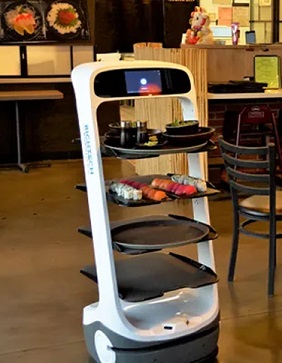LOS ANGELES—The future of automation technologies will play a significant role in restaurant automation strategy. However, the jury is out on the emergence of robots in restaurants. Some individuals view them as a threat to jobs and the ever so important human element of hospitality, while others see them as a cost-saving revolution that will alleviate the ever-acute staffing crises. Whatever the public opinion, reality dictates that robots are taking over certain restaurant tasks and systems that directly impact the restaurant experience.

Several factors including rising labor costs, a labor shortage, expensive rents, and employee turnover have led restaurateurs to look at automating repetitive tasks—actively reducing labor deployment requirements and increasing profitability. Robots are, therefore, the most obvious and vociferous next step.
“Robots are now found in various types of restaurants; from Royal Caribbean cruise ships, that use robotic bartenders, to Costco pizza-making robots, which have helped keep prices low. Other fast-food chains, such as Chipotle and Picnic, have updated their operations with robotic technology to create tortilla chips or make up to 100 pizzas per hour,” says Robert Ancill of The Next Idea Group.
From Support Roles to Servers, Bartenders & More
Presently, robots are more likely to support restaurant staff by carrying out tasks such as chopping ingredients or cleaning. Automation is also being used to improve the customer experiences when making reservations, placing orders, or paying for their meals. Order kiosks in place of cash registers is becoming more prevalent. However, as the future becomes the present, we will begin to see the introduction of human-like robotic servers, bartenders, hosts and even valet attendants, consequently robots are only in their infancy and will evolve quickly over the foreseeable future.
In regards to fears of innovation Ancill insists that, “As with any technological shift, for the industry to remain competitive, it must stay ahead of the curve and leverage automation to improve the customer experience while integrating with existing human labor. The future will undoubtedly see more robots entering the hospitality sector; thus it remains essential to determine the best way to engage them in enhancing the guest experience while rising to the challenge of adjusting labor needs through careful task deployment.”
Restaurant and kitchen design needs to quickly adapt to the new reality of not just the guest experience, but the operational interface between guests and robots, as well as a harmonious relationship between robots and employees. Design will need to consider traveling robots, floor finishes and damage control should robots malfunction such as items falling from robot arms. Equally challenging is the sheer logistics of operating robots in a confined space; power requirements, ports for robots not in use, as well as maintenance, all need consideration as the new AI normal materializes.
Examples of Robots in Use
As technology advances, robots will unquestionably prevail in fast-food kitchens, making the culinary operations faster, more efficient, and more profitable. A few examples of early adopters include Chipotle’s Chippy robot which can make fresh tortilla chips at a California location. Food tech company, Picnic, operates a robot that can make up to 100 pizzas per hour. Jamba worked with the smoothie-making robot Blendid to create a robotic smoothie kiosk.
“Additionally, robots are being used for delivery, providing restaurants with another dynamic methodology to reach customers in their homes and workplace,” Ancill says. “The risk of a robot eating part of the order, as has been the complaint with human third-party delivery, is impossible with a robot. Thus, the positive guest experience is more controllable and consistent, assuming the robots don’t start to do it their way.”
The dine-in industry is also considering intelligent unmanned dining-room delivery solutions. These are robots that are essentially trays on wheels, programed to deliver food, and allow guests to clear their table with the robot transporting the plates back to the dishwasher area.
Chili’s Robot Did Not Work Out
Despite optimistic expectations, the introduction of new robotic technologies into restaurant services has experienced challenges. For example, Chili’s tried out a robot server named Rita at 61 locations in 2020 but was forced to end its experiment due to slow movement and negative customer feedback. Similarly, Haidilao hot pot chain outlets have reported that robots are less reliable or cost-effective than human servers when it comes to delivering food.
“With the rise of automation in the restaurant industry, staying ahead is essential,” Ancill advises. “Robots won’t be a replacement for staff anytime soon, but they can become part of teams and help make restaurants more efficient while still providing an excellent guest experience. Factoring this into strategy could give eateries that competitive edge to stay afloat amidst rising labor costs and customer demands.”
Robots are more likely to act as support for human staff; helping with tasks like chopping ingredients or cleaning in a similar way that automation tools are already being used to improve the guest experience when making a reservation, ordering at the table, and paying for meals.
Go to www.tnidesign.com for more information.
Robert Ancill, the CEO of The Next Idea Group, is well known as one of America’s leading restaurant design consultants and analyzes robotics trends in the industry.





